计算机网络课后习题作业
(完整版)计算机网络原理课后习题答案
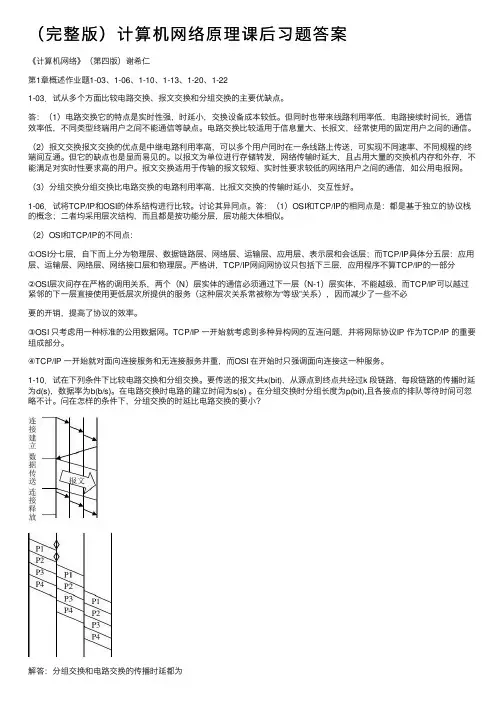
(完整版)计算机⽹络原理课后习题答案《计算机⽹络》(第四版)谢希仁第1章概述作业题1-03、1-06、1-10、1-13、1-20、1-221-03.试从多个⽅⾯⽐较电路交换、报⽂交换和分组交换的主要优缺点。
答:(1)电路交换它的特点是实时性强,时延⼩,交换设备成本较低。
但同时也带来线路利⽤率低,电路接续时间长,通信效率低,不同类型终端⽤户之间不能通信等缺点。
电路交换⽐较适⽤于信息量⼤、长报⽂,经常使⽤的固定⽤户之间的通信。
(2)报⽂交换报⽂交换的优点是中继电路利⽤率⾼,可以多个⽤户同时在⼀条线路上传送,可实现不同速率、不同规程的终端间互通。
但它的缺点也是显⽽易见的。
以报⽂为单位进⾏存储转发,⽹络传输时延⼤,且占⽤⼤量的交换机内存和外存,不能满⾜对实时性要求⾼的⽤户。
报⽂交换适⽤于传输的报⽂较短、实时性要求较低的⽹络⽤户之间的通信,如公⽤电报⽹。
(3)分组交换分组交换⽐电路交换的电路利⽤率⾼,⽐报⽂交换的传输时延⼩,交互性好。
1-06.试将TCP/IP和OSI的体系结构进⾏⽐较。
讨论其异同点。
答:(1)OSI和TCP/IP的相同点是:都是基于独⽴的协议栈的概念;⼆者均采⽤层次结构,⽽且都是按功能分层,层功能⼤体相似。
(2)OSI和TCP/IP的不同点:①OSI分七层,⾃下⽽上分为物理层、数据链路层、⽹络层、运输层、应⽤层、表⽰层和会话层;⽽TCP/IP具体分五层:应⽤层、运输层、⽹络层、⽹络接⼝层和物理层。
严格讲,TCP/IP⽹间⽹协议只包括下三层,应⽤程序不算TCP/IP的⼀部分②OSI层次间存在严格的调⽤关系,两个(N)层实体的通信必须通过下⼀层(N-1)层实体,不能越级,⽽TCP/IP可以越过紧邻的下⼀层直接使⽤更低层次所提供的服务(这种层次关系常被称为“等级”关系),因⽽减少了⼀些不必要的开销,提⾼了协议的效率。
③OSI 只考虑⽤⼀种标准的公⽤数据⽹。
TCP/IP ⼀开始就考虑到多种异构⽹的互连问题,并将⽹际协议IP 作为TCP/IP 的重要组成部分。
计算机网络课后作业答案
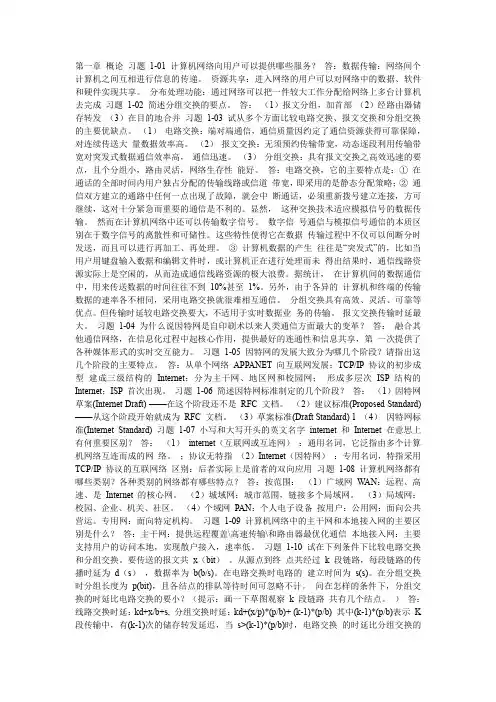
第一章概论习题1-01 计算机网络向用户可以提供哪些服务?答:数据传输:网络间个计算机之间互相进行信息的传递。
资源共享:进入网络的用户可以对网络中的数据、软件和硬件实现共享。
分布处理功能:通过网络可以把一件较大工作分配给网络上多台计算机去完成习题1-02 简述分组交换的要点。
答:(1)报文分组,加首部(2)经路由器储存转发(3)在目的地合并习题1-03 试从多个方面比较电路交换、报文交换和分组交换的主要优缺点。
(1)电路交换:端对端通信,通信质量因约定了通信资源获得可靠保障,对连续传送大量数据效率高。
(2)报文交换:无须预约传输带宽,动态逐段利用传输带宽对突发式数据通信效率高,通信迅速。
(3)分组交换:具有报文交换之高效迅速的要点,且个分组小,路由灵活,网络生存性能好。
答:电路交换,它的主要特点是:①在通话的全部时间内用户独占分配的传输线路或信道带宽,即采用的是静态分配策略;②通信双方建立的通路中任何一点出现了故障,就会中断通话,必须重新拨号建立连接,方可继续,这对十分紧急而重要的通信是不利的。
显然,这种交换技术适应模拟信号的数据传输。
然而在计算机网络中还可以传输数字信号。
数字信号通信与模拟信号通信的本质区别在于数字信号的离散性和可储性。
这些特性使得它在数据传输过程中不仅可以间断分时发送,而且可以进行再加工、再处理。
③计算机数据的产生往往是“突发式”的,比如当用户用键盘输入数据和编辑文件时,或计算机正在进行处理而未得出结果时,通信线路资源实际上是空闲的,从而造成通信线路资源的极大浪费。
据统计,在计算机间的数据通信中,用来传送数据的时间往往不到10%甚至1%。
另外,由于各异的计算机和终端的传输数据的速率各不相同,采用电路交换就很难相互通信。
分组交换具有高效、灵活、可靠等优点。
但传输时延较电路交换要大,不适用于实时数据业务的传输。
报文交换传输时延最大。
习题1-04 为什么说因特网是自印刷术以来人类通信方面最大的变革?答:融合其他通信网络,在信息化过程中起核心作用,提供最好的连通性和信息共享,第一次提供了各种媒体形式的实时交互能力。
计算机网络第六版课后习题答案
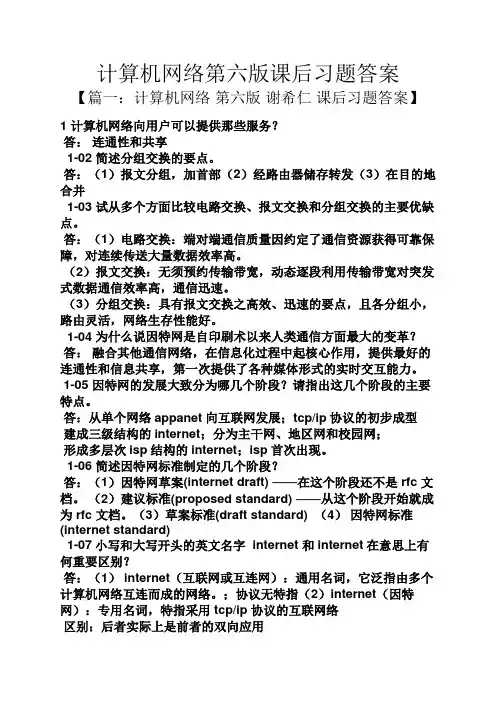
计算机网络第六版课后习题答案【篇一:计算机网络第六版谢希仁课后习题答案】1 计算机网络向用户可以提供那些服务?答:连通性和共享1-02 简述分组交换的要点。
答:(1)报文分组,加首部(2)经路由器储存转发(3)在目的地合并1-03 试从多个方面比较电路交换、报文交换和分组交换的主要优缺点。
答:(1)电路交换:端对端通信质量因约定了通信资源获得可靠保障,对连续传送大量数据效率高。
(2)报文交换:无须预约传输带宽,动态逐段利用传输带宽对突发式数据通信效率高,通信迅速。
(3)分组交换:具有报文交换之高效、迅速的要点,且各分组小,路由灵活,网络生存性能好。
1-04 为什么说因特网是自印刷术以来人类通信方面最大的变革?答:融合其他通信网络,在信息化过程中起核心作用,提供最好的连通性和信息共享,第一次提供了各种媒体形式的实时交互能力。
1-05 因特网的发展大致分为哪几个阶段?请指出这几个阶段的主要特点。
答:从单个网络appanet向互联网发展;tcp/ip协议的初步成型建成三级结构的internet;分为主干网、地区网和校园网;形成多层次isp结构的internet;isp首次出现。
1-06 简述因特网标准制定的几个阶段?答:(1)因特网草案(internet draft) ——在这个阶段还不是 rfc 文档。
(2)建议标准(proposed standard) ——从这个阶段开始就成为 rfc 文档。
(3)草案标准(draft standard) (4)因特网标准(internet standard)1-07小写和大写开头的英文名字 internet 和internet在意思上有何重要区别?答:(1) internet(互联网或互连网):通用名词,它泛指由多个计算机网络互连而成的网络。
;协议无特指(2)internet(因特网):专用名词,特指采用 tcp/ip 协议的互联网络区别:后者实际上是前者的双向应用1-08 计算机网络都有哪些类别?各种类别的网络都有哪些特点?答:按范围:(1)广域网wan:远程、高速、是internet的核心网。
计算机网络课后习题答案(第四章2)
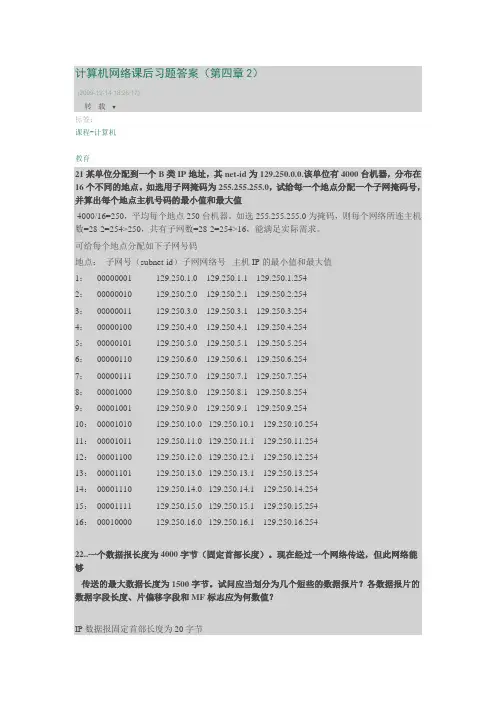
计算机网络课后习题答案(第四章2)(2009-12-14 18:26:17)转载▼标签:课程-计算机教育21某单位分配到一个B类IP地址,其net-id为129.250.0.0.该单位有4000台机器,分布在16个不同的地点。
如选用子网掩码为255.255.255.0,试给每一个地点分配一个子网掩码号,并算出每个地点主机号码的最小值和最大值4000/16=250,平均每个地点250台机器。
如选255.255.255.0为掩码,则每个网络所连主机数=28-2=254>250,共有子网数=28-2=254>16,能满足实际需求。
可给每个地点分配如下子网号码地点:子网号(subnet-id)子网网络号主机IP的最小值和最大值1: 00000001 129.250.1.0 129.250.1.1---129.250.1.2542: 00000010 129.250.2.0 129.250.2.1---129.250.2.2543: 00000011 129.250.3.0 129.250.3.1---129.250.3.2544: 00000100 129.250.4.0 129.250.4.1---129.250.4.2545: 00000101 129.250.5.0 129.250.5.1---129.250.5.2546: 00000110 129.250.6.0 129.250.6.1---129.250.6.2547: 00000111 129.250.7.0 129.250.7.1---129.250.7.2548: 00001000 129.250.8.0 129.250.8.1---129.250.8.2549: 00001001 129.250.9.0 129.250.9.1---129.250.9.25410: 00001010 129.250.10.0 129.250.10.1---129.250.10.25411: 00001011 129.250.11.0 129.250.11.1---129.250.11.25412: 00001100 129.250.12.0 129.250.12.1---129.250.12.25413: 00001101 129.250.13.0 129.250.13.1---129.250.13.25414: 00001110 129.250.14.0 129.250.14.1---129.250.14.25415: 00001111 129.250.15.0 129.250.15.1---129.250.15.25416: 00010000 129.250.16.0 129.250.16.1---129.250.16.25422..一个数据报长度为4000字节(固定首部长度)。
1.计算机网络原理第一章课后习题及答案
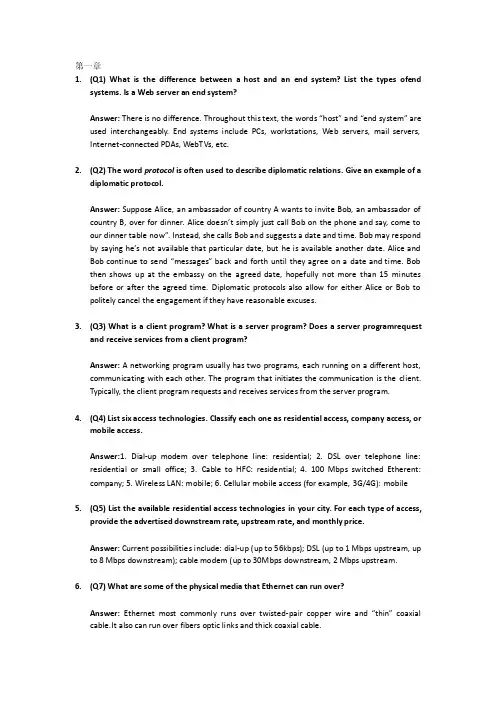
第一章1.(Q1) What is the difference between a host and an end system? List the types ofendsystems. Is a Web server an end system?Answer: There is no difference. Throughout this text, the words “host” and “end system” are used interchangeably. End systems include PCs, workstations, Web servers, mail servers, Internet-connected PDAs, WebTVs, etc.2.(Q2) The word protocol is often used to describe diplomatic relations. Give an example of adiplomatic protocol.Answer: Suppose Alice, an ambassador of country A wants to invite Bob, an ambassador of country B, over for dinner. Alice doesn’t simply just call Bob on the phone and say, come to our dinner table now”. Instead, she calls Bob and sugges ts a date and time. Bob may respond by saying he’s not available that particular date, but he is available another date. Alice and Bob continue to send “messages” back and forth until they agree on a date and time. Bob then shows up at the embassy on the agreed date, hopefully not more than 15 minutes before or after the agreed time. Diplomatic protocols also allow for either Alice or Bob to politely cancel the engagement if they have reasonable excuses.3.(Q3) What is a client program? What is a server program? Does a server programrequestand receive services from a client program?Answer: A networking program usually has two programs, each running on a different host, communicating with each other. The program that initiates the communication is the client.Typically, the client program requests and receives services from the server program.4.(Q4) List six access technologies. Classify each one as residential access, company access, ormobile access.Answer:1. Dial-up modem over telephone line: residential; 2. DSL over telephone line: residential or small office; 3. Cable to HFC: residential; 4. 100 Mbps switched Etherent: company; 5. Wireless LAN: mobile; 6. Cellular mobile access (for example, 3G/4G): mobile5.(Q5) List the available residential access technologies in your city. For each type of access,provide the advertised downstream rate, upstream rate, and monthly price.Answer: Current possibilities include: dial-up (up to 56kbps); DSL (up to 1 Mbps upstream, up to 8 Mbps downstream); cable modem (up to 30Mbps downstream, 2 Mbps upstream.6.(Q7) What are some of the physical media that Ethernet can run over?Answer: Ethernet most commonly runs over twisted-pair copper wire and “thin” coaxial cable.It also can run over fibers optic links and thick coaxial cable.7.(Q8)Dial-up modems, HFC, and DSL are all used for residential access. For each of theseaccess technologies, provide a range of transmission rates and comment on whether the transmission rate is shared or dedicated.Answer:Dial up modems: up to 56 Kbps, bandwidth is dedicated; ISDN: up to 128 kbps, bandwidth is dedicated; ADSL: downstream channel is .5-8 Mbps, upstream channel is up to1 Mbps, bandwidth is dedicated; HFC, downstream channel is 10-30 Mbps and upstreamchannel is usually less than a few Mbps, bandwidth is shared.8.(Q13)Why is it said that packet switching employs statistical multiplexing? Contraststatistical multiplexing with the multiplexing that takes place in TDM.Answer:In a packet switched network, the packets from different sources flowing on a link do not follow any fixed, pre-defined pattern. In TDM circuit switching, each host gets the same slot in a revolving TDM frame.9.(Q14) Suppose users share a 2Mbps link. Also suppose each user requires 1Mbps whentransmitting, but each user transmits only 20 percent of the time. (See the discussion of statistical multiplexing in Section 1.3.)a.When circuit switching is used, how many users can be supported?b.For the remainder of this problem, suppose packet switching is used. Why will there beessentially no queuing delay before the link if two or fewer users transmit at the same time? Why will there be a queuing delay if three users transmit at the same time?c.Find the probability that a given user is transmitting.d.Suppose now there are three users. Find the probability that at any given time, allthree users are transmitting simultaneously. Find the fraction of time during which the queue grows.Answer:a. 2 users can be supported because each user requires half of the link bandwidth.b.Since each user requires 1Mbps when transmitting, if two or fewer users transmitsimultaneously, a maximum of 2Mbps will be required. Since the available bandwidth of the shared link is 2Mbps, there will be no queuing delay before the link. Whereas, if three users transmit simultaneously, the bandwidth required will be 3Mbps which is more than the available bandwidth of the shared link. In this case, there will be queuing delay before the link.c.Probability that a given user is transmitting = 0.2d.Probability that all three users are transmitting simultaneously=33p3(1−p)0=0.23=0.008. Since the queue grows when all the users are transmitting, the fraction oftime during which the queue grows (which is equal to the probability that all three users are transmitting simultaneously) is 0.008.10.(Q16)Consider sending a packet from a source host to a destination host over a fixed route.List the delay components in the end-to-end delay. Which of these delays are constant and which are variable?Answer:The delay components are processing delays, transmission delays, propagation delays, and queuing delays. All of these delays are fixed, except for the queuing delays, which are variable.11.(Q19) Suppose Host A wants to send a large file to Host B. The path from Host A to Host Bhas three links, of rates R1 = 250 kbps, R2 = 500 kbps, and R3 = 1 Mbps.a.Assuming no other traffic in the network, what is the throughput for the file transfer.b.Suppose the file is 2 million bytes. Roughly, how long will it take to transfer the file toHost B?c.Repeat (a) and (b), but now with R2 reduced to 200 kbps.Answer:a.250 kbpsb.64 secondsc.200 kbps; 80 seconds12.(P2)Consider the circuit-switched network in Figure 1.8. Recall that there are n circuits oneach link.a.What is the maximum number of simultaneous connections that can be in progress atany one time in this network?b.Suppose that all connections are between the switch in the upper-left-hand cornerand the switch in the lower-right-hand corner. What is the maximum number ofsimultaneous connections that can be in progress?Answer:a.We can n connections between each of the four pairs of adjacent switches. This gives amaximum of 4n connections.b.We can n connections passing through the switch in the upper-right-hand cornerandanother n connections passing through the switch in the lower-left-hand corner, giving a total of 2n connections.13.(P4) Review the car-caravan analogy in Section 1.4. Assume a propagation speed of 50km/hour.a.Suppose the caravan travels 150 km, beginning in front of one tollbooth, passingthrough a second tollbooth, and finishing just before a third tollbooth. What is theend-to-end delay?b.Repeat (a), now assuming that there are five cars in the caravan instead of ten.Answer: Tollbooths are 150 km apart, and the cars propagate at 50 km/hr, A tollbooth services a car at a rate of one car every 12 seconds.a.There are ten cars. It takes 120 seconds, or two minutes, for the first tollbooth to servicethe 10 cars. Each of these cars has a propagation delay of 180 minutes before arriving at the second tollbooth. Thus, all the cars are lined up before the second tollbooth after 182 minutes. The whole process repeats itself for traveling between the second and third tollbooths. Thus the total delay is 364 minutes.b.Delay between tollbooths is 5*12 seconds plus 180 minutes, i.e., 181minutes. The totaldelay is twice this amount, i.e., 362 minutes.14.(P5) This elementary problem begins to explore propagation delay and transmission delay,two central concepts in data networking. Consider two hosts, A and B, connected by a single link of rate R bps. Suppose that the two hosts are separated by m meters, and suppose the propagation speed along the link is s meters/sec. Host A is to send a packet of size L bits to Host B.a.Express the propagation delay, d prop , in terms of m and s.b.Determine the transmission time of the packet, d trans, in terms of L and R.c.Ignoring processing and queuing delays, obtain an expression for the end-to-enddelay.d.Suppose Host A begins to transmit the packet at time t = 0. At time t = d trans, where isthe last bit of the packet?e.Suppose d prop is greater than d trans. At time t = d trans, where is the first bit of thepacket?f.Suppose d prop is less than d trans.At time t = d trans,where is the first bit of the packet?g.Suppose s = 2.5*108, L = 100bits, and R = 28kbps. Find the distance m so that dprop equals d trans .Answer:a. d prop = m/s seconds.b. d trans = L/R seconds.c. d end-to-end = (m/s + L/R) seconds.d.The bit is just leaving Host A.e.The first bit is in the link and has not reached Host B.f.The first bit has reached Host B.g.Wantm=LRS=10028∗1032.5∗108=893 km.15.(P6) In this problem we consider sending real-time voice from Host A to Host B over apacket-switched network (VoIP). Host A converts analog voice to a digital 64 kbps bit stream on the fly. Host A then groups the bits into 56-Byte packets. There is one link between Host A and B; its transmission rate is 500 kbps and its propagation delay is 2 msec.As soon as Host A gathers a packet, it sends it to Host B. As soon as Host B receives an entire packet, it converts the packet’s bits to an analog signal. How much time elapses from the time a bit is created (from the original analog signal at Host A) until the bit is decoded(as part of the analog signal at Host B)?Answer: Consider the first bit in a packet. Before this bit can be transmitted, all of the bits in thepacket must be generated. This requires56∗8sec=7 msec64∗103The time required to transmit the packet is56∗8sec=896 μsec500∗103Propagation delay = 2 msec.The delay until decoding is7msec +896μsec + 2msec = 9.896msecA similar analysis shows that all bits experience a delay of 9.896 msec.16.(P9) Consider a packet of length L which begins at end system A, travels over one link to apacket switch, and travels from the packet switch over a second link to a destination end system. Let d i, s i, and R i denote the length, propagation speed, and the transmission rate of link i, for i= 1, 2. The packet switch delays each packet by d proc. Assuming no queuing delays, in terms of d i, s i, R i, (i= 1, 2), and L, what is the total end-to-end delay for the packet? Suppose now the packet Length is 1,000 bytes, the propagation speed on both links is 2.5 * 108m/s, the transmission rates of both links is 1 Mbps, the packet switch processing delay is 2 msec, the length of the first link is 6,000 km, and the length of the last link is 3,000 km. For these values, what is the end-to-end delay?Answer: The first end system requires L/R1to transmit the packet onto the first link; the packet propagates over the first link in d1/s1; the packet switch adds a processing delay ofd proc; after receiving the entire packet, the packet switch requires L/R2to transmit the packetonto the second link; the packet propagates over the second link in d2/s2. Adding these five delays givesd end-end = L/R1 + L/R2 + d1/s1 + d2/s2 + d procTo answer the second question, we simply plug the values into the equation to get 8 + 8 +24 + 12 + 2= 54 msec.17.(P10) In the above problem, suppose R1 = R2 = R and d proc= 0. Further suppose the packetswitch does not store-and-forward packets but instead immediately transmits each bit it receivers before waiting for the packet to arrive. What is the end-to-end delay?Answer: Because bits are immediately transmitted, the packet switch does not introduce any delay;in particular, it does not introduce a transmission delay. Thus,d end-end = L/R + d1/s1 + d2/s2For the values in Problem 9, we get 8 + 24 + 12 = 44 msec.18.(P11) Suppose N packets arrive simultaneously to a link at which no packets are currentlybeing transmitted or queued. Each packet is of length L and the link has transmission rate R.What is the average queuing delay for the N packets?Answer:The queuing delay is 0 for the first transmitted packet, L/R for the second transmitted packet, and generally, (n-1)L/R for the nth transmitted packet. Thus, the average delay for the N packets is(L/R + 2L/R + ....... + (N-1)L/R)/N = L/RN(1 + 2 + ..... + (N-1)) = LN(N-1)/(2RN) = (N-1)L/(2R) Note that here we used the well-known fact that1 +2 + ....... + N = N(N+1)/219.(P14) Consider the queuing delay in a router buffer. Let I denote traffic intensity; that is, I =La/R. Suppose that the queuing delay takes the form IL/R (1-I) for I<1.a.Provide a formula for the total delay, that is, the queuing delay plus the transmissiondelay.b.Plot the total delay as a function of L/R.Answer:a.The transmission delay is L / R . The total delay isILR(1−I)+LR=L/R1−Ib.Let x = L / R.Total delay=x 1−αx20.(P16) Perform a Traceroute between source and destination on the same continent at threedifferent hours of the day.a.Find the average and standard deviation of the round-trip delays at each of the threehours.b.Find the number of routers in the path at each of the three hours. Did the pathschange during any of the hours?c.Try to identify the number of ISP networks that the Traceroute packets pass throughfrom source to destination. Routers with similar names and/or similar IP addresses should be considered as part of the same ISP. In your experiments, do the largest delays occur at the peering interfaces between adjacent ISPs?d.Repeat the above for a source and destination on different continents. Compare theintra-continent and inter-continent results.Answer: Experiments.21.(P18) Suppose two hosts, A and B, are separated by 10,000 kilometers and are conn ectedby a direct link of R =2 Mbps. Suppose the propagation speed over the link is 2.5•108 meters/sec.a.Calculate the bandwidth-delay product, R•d prop.b.Consider sending a file of 400,000 bits from Host A to Host B. Suppose the file is sentcontinuously as one large message. What is the maximum number of bits that will be in the link at any given time?c.Provide an interpretation of the bandwidth-delay product.d.What is the width (in meters) of a bit in the link? Is it longer than a football field?e.Derive a general expression for the width of a bit in terms of the propagation speed s,the transmission rate R, and the length of the link m.Answer:a.d prop= 107 / 2.5•108= 0.04 sec; so R •d prop= 80,000bitsb.80,000bitsc.The bandwidth-delay product of a link is the maximum number of bits that can be inthelink.d. 1 bit is 125 meters long, which is longer than a football fielde.m / (R •d prop ) = m / (R * m / s) = s/R22.(P20) Consider problem P18 but now with a link of R = 1 Gbps.a.Calculate the bandwidth-delay product,R·d prop .b.Consider sending a file of 400,000 bits from Host A to Host B. Suppose the file is sentcontinuously as one big message. What is the maximum number of bits that will be inthe link at any given time?c.What is the width (in meters) of a bit in the link?Answer:a.40,000,000 bits.b.400,000 bits.c.0.25 meters.23.(P21) Refer again to problem P18.a.How long does it take to send the file, assuming it is sent continuously?b.Suppose now the file is broken up into 10 packet is acknowledged by the receiver andthe transmission time of an acknowledgment packet is negligible. Finally, assumethat the sender cannot send a packet until the preceding one is acknowledged. Howlong does it take to send the file?pare the results from (a) and (b).Answer:a. d trans + d prop = 200 msec + 40 msec = 240 msecb.10 * (t trans + 2 t prop ) = 10 * (20 msec + 80 msec) = 1.0sec。
计算机网络(第六版)课后习题答案
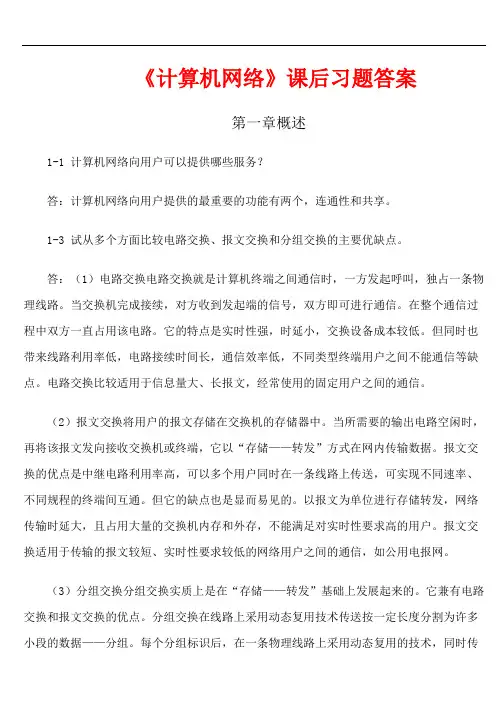
《计算机网络》课后习题答案第一章概述1-1 计算机网络向用户可以提供哪些服务?答:计算机网络向用户提供的最重要的功能有两个,连通性和共享。
1-3 试从多个方面比较电路交换、报文交换和分组交换的主要优缺点。
答:(1)电路交换电路交换就是计算机终端之间通信时,一方发起呼叫,独占一条物理线路。
当交换机完成接续,对方收到发起端的信号,双方即可进行通信。
在整个通信过程中双方一直占用该电路。
它的特点是实时性强,时延小,交换设备成本较低。
但同时也带来线路利用率低,电路接续时间长,通信效率低,不同类型终端用户之间不能通信等缺点。
电路交换比较适用于信息量大、长报文,经常使用的固定用户之间的通信。
(2)报文交换将用户的报文存储在交换机的存储器中。
当所需要的输出电路空闲时,再将该报文发向接收交换机或终端,它以“存储——转发”方式在网内传输数据。
报文交换的优点是中继电路利用率高,可以多个用户同时在一条线路上传送,可实现不同速率、不同规程的终端间互通。
但它的缺点也是显而易见的。
以报文为单位进行存储转发,网络传输时延大,且占用大量的交换机内存和外存,不能满足对实时性要求高的用户。
报文交换适用于传输的报文较短、实时性要求较低的网络用户之间的通信,如公用电报网。
(3)分组交换分组交换实质上是在“存储——转发”基础上发展起来的。
它兼有电路交换和报文交换的优点。
分组交换在线路上采用动态复用技术传送按一定长度分割为许多小段的数据——分组。
每个分组标识后,在一条物理线路上采用动态复用的技术,同时传送多个数据分组。
把来自用户发端的数据暂存在交换机的存储器内,接着在网内转发。
到达接收端,再去掉分组头将各数据字段按顺序重新装配成完整的报文。
分组交换比电路交换的电路利用率高,比报文交换的传输时延小,交互性好。
1-5 因特网的发展大致分为哪几个阶段?请指出这几个阶段最主要的特点。
答:第一阶段是从单个网络ARPANRET 向互联网发展的过程。
最初的分组交换网ARPANET 只是一个单个的分组交换网,所有要连接在ARPANET 上的主机都直接与就近的结点交换机相连。
计算机网络课后习题答案(谢希仁)
<<计算机网络>> 谢希仁编著---习题解答第一章概述习题1-02 试简述分组交换的要点。
答:采用存储转发的分组交换技术,实质上是在计算机网络的通信过程中动态分配传输线路或信道带宽的一种策略。
它的工作机理是:首先将待发的数据报文划分成若干个大小有限的短数据块,在每个数据块前面加上一些控制信息(即首部),包括诸如数据收发的目的地址、源地址,数据块的序号等,形成一个个分组,然后各分组在交换网内采用“存储转发”机制将数据从源端发送到目的端。
由于节点交换机暂时存储的是一个个短的分组,而不是整个的长报文,且每一分组都暂存在交换机的内存中并可进行相应的处理,这就使得分组的转发速度非常快。
分组交换网是由若干节点交换机和连接这些交换机的链路组成,每一结点就是一个小型计算机。
基于分组交换的数据通信是实现计算机与计算机之间或计算机与人之间的通信,其通信过程需要定义严格的协议;分组交换网的主要优点:1、高效。
在分组传输的过程中动态分配传输带宽。
2、灵活。
每个结点均有智能,可根据情况决定路由和对数据做必要的处理。
3、迅速。
以分组作为传送单位,在每个结点存储转发,网络使用高速链路。
4、可靠。
完善的网络协议;分布式多路由的通信子网。
电路交换相比,分组交换的不足之处是:①每一分组在经过每一交换节点时都会产生一定的传输延时,考虑到节点处理分组的能力和分组排队等候处理的时间,以及每一分组经过的路由可能不等同,使得每一分组的传输延时长短不一。
因此,它不适用于一些实时、连续的应用场合,如电话话音、视频图像等数据的传输;②由于每一分组都额外附加一个头信息,从而降低了携带用户数据的通信容量;③分组交换网中的每一节点需要更多地参与对信息转换的处理,如在发送端需要将长报文划分为若干段分组,在接收端必须按序将每个分组组装起来,恢复出原报文数据等,从而降低了数据传输的效率。
习题1-03 试从多个方面比较电路交换、报文交换和分组交换的主要优缺点。
计算机网络课后习题答案谢希仁第五版
<<计算机网络>> 谢希仁编著---习题解答第一章概述习题1-02 试简述分组交换的要点。
答:采用存储转发的分组交换技术,实质上是在计算机网络的通信过程中动态分配传输线路或信道带宽的一种策略。
它的工作机理是:首先将待发的数据报文划分成若干个大小有限的短数据块,在每个数据块前面加上一些控制信息(即首部),包括诸如数据收发的目的地址、源地址,数据块的序号等,形成一个个分组,然后各分组在交换网内采用“存储转发”机制将数据从源端发送到目的端。
由于节点交换机暂时存储的是一个个短的分组,而不是整个的长报文,且每一分组都暂存在交换机的内存中并可进行相应的处理,这就使得分组的转发速度非常快。
分组交换网是由若干节点交换机和连接这些交换机的链路组成,每一结点就是一个小型计算机。
基于分组交换的数据通信是实现计算机与计算机之间或计算机与人之间的通信,其通信过程需要定义严格的协议;分组交换网的主要优点:1、高效。
在分组传输的过程中动态分配传输带宽。
2、灵活。
每个结点均有智能,可根据情况决定路由和对数据做必要的处理。
3、迅速。
以分组作为传送单位,在每个结点存储转发,网络使用高速链路。
4、可靠。
完善的网络协议;分布式多路由的通信子网。
电路交换相比,分组交换的不足之处是:①每一分组在经过每一交换节点时都会产生一定的传输延时,考虑到节点处理分组的能力和分组排队等候处理的时间,以及每一分组经过的路由可能不等同,使得每一分组的传输延时长短不一。
因此,它不适用于一些实时、连续的应用场合,如电话话音、视频图像等数据的传输;②由于每一分组都额外附加一个头信息,从而降低了携带用户数据的通信容量;③分组交换网中的每一节点需要更多地参与对信息转换的处理,如在发送端需要将长报文划分为若干段分组,在接收端必须按序将每个分组组装起来,恢复出原报文数据等,从而降低了数据传输的效率。
习题1-03 试从多个方面比较电路交换、报文交换和分组交换的主要优缺点。
《计算机网络》第6章课后习题
1.与广域网相比,局域网有哪些特点?参考答案:1)较小的地域范围。
2)传输速率高,误码率低。
3)通常为一个单位所建,并自行管理和使用。
4)可使用的传输介质较丰富。
5)较简单的网络拓扑结构。
6)有限的站点数量。
2. 局域网的3个关键技术是什么?试分析10BASE-T以太网所采用的技术。
参考答案:局域网的三个关键技术是拓扑结构、数据传输形式及介质访问控制方法。
10BASE-T以太网的物理拓扑结构为星型(逻辑拓扑结构为总线型),采用基带传输,使用CSMA/CD的介质访问控制方法。
3.以太网与总线网这两个概念有什么关系?参考答案:总线网是指拓扑结构为总线的网络,而以太网是指采用CSMA/CD介质访问控制方法的局域网,早期以太网的物理拓扑结构采用了总线型拓扑,也属于总线型网络,但现在的以太网大多为星型拓扑。
4.以太网与IEEE802.3网络的相同点有哪些?不同点有哪些?参考答案:二者都采用了总线型拓扑结构和基带传输方法,并且都使用CSMA/CD的介质访问控制方法。
不同之处主要有:1)帧结构有些细微的差别:帧首部的第13-14位的定义不同,IEEE802.3定义为数据字段的长度,而DIX Ethernet II定义为网络层协议类型;2)介质稍有不同,IEEE802.3标准定义了同轴电缆、双绞线和光纤三种介质,而DIX Ethernet II只使用同轴电缆。
5.IEEE 802标准规定了哪些层次?参考答案:IEEE 802标准规定了物理层和数据链路层两个层次。
其中又把数据链路层分为逻辑链路控制(LLC)和介质访问控制(MAC)两个功能子层。
6.试分析CSMA/CD介质访问控制技术的工作原理。
参考答案:CSMA/CD介质访问控制技术被广泛应用于以太网中。
CSMA/CD的工作原理是:当某个站点要发送数据时,它首先监听介质:①如果介质是空闲的,则发送;②如果介质是忙的,则继续监听,一旦发现介质空闲,就立即发送;③站点在发送帧的同时需要继续监听是否发生冲突(碰撞),若在帧发送期间检测到冲突,就立即停止发送,并向介质发送一串阻塞信号以强化冲突,保证让总线上的其他站点都知道已发生了冲突;④发送了阻塞信号后,等待一段随机时间,返回步骤①重试。
计算机网络(第二版)课后习题答案
计算机网络(第二版)课后习题答案计算机网络(第二版)课后习题答案一、绪论计算机网络是指在多个计算机之间传输数据和共享资源的系统。
随着互联网的普及和发展,计算机网络已经成为现代社会中不可或缺的组成部分。
本文将回答《计算机网络(第二版)》课后习题,并提供详细的解答。
二、物理层1. 什么是物理层?物理层的任务是什么?物理层是计算机网络模型中的第一层,主要负责传输比特流。
其任务包括确定物理传输媒介的规范、数据的编码认证、物理连接的建立和维护等。
2. 传输媒介可分为哪几种类型?各有什么特点?传输媒介可分为有线传输媒介和无线传输媒介两种类型。
有线传输媒介包括双绞线、同轴电缆和光纤等,其特点是传输速度快、传输距离较长、抗干扰能力强。
无线传输媒介包括无线电波和红外线等,其特点是灵活性高、易于扩展和部署,但传输速度和距离受到限制。
3. 什么是调制和解调?其作用是什么?调制是将数字信号转换为模拟信号的过程,解调是将模拟信号转换为数字信号的过程。
调制和解调的作用是在发送端将数字数据转换为适合在传输媒介上传输的模拟信号,然后在接收端将模拟信号转换为可被计算机理解的数字数据。
4. 什么是信道复用?常见的信道复用技术有哪些?信道复用是指通过合理地利用通信线路,将不同用户的数据流合并在一起传输的技术。
常见的信道复用技术包括频分复用(FDM)、时分复用(TDM)和码分复用(CDM)等。
三、数据链路层1. 数据链路层有哪些基本的功能?数据链路层的基本功能包括封装成帧、物理寻址、错误检测和流量控制等。
封装成帧将网络层交付的数据分成适当的数据帧进行传输;物理寻址通过物理地址标识源和目的设备;错误检测使用帧检验序列等方法检测传输中的错误;流量控制通过控制数据的发送速率来保证接收端能够正确接收数据。
2. 什么是差错控制?常见的差错检测技术有哪些?差错控制是指在数据传输过程中采取一定的机制来检测和纠正传输中发生的差错。
常见的差错检测技术有纵向奇偶校验、循环冗余检验(CRC)和海明码等。
- 1、下载文档前请自行甄别文档内容的完整性,平台不提供额外的编辑、内容补充、找答案等附加服务。
- 2、"仅部分预览"的文档,不可在线预览部分如存在完整性等问题,可反馈申请退款(可完整预览的文档不适用该条件!)。
- 3、如文档侵犯您的权益,请联系客服反馈,我们会尽快为您处理(人工客服工作时间:9:00-18:30)。
1 计算机网络课后习题 第三课 1 在一个信道中,用8种不同电平来传输数据,每秒传输100k个电平,这个信道的波特率是多少?比特率是多少? 答:波特率 100k,比特率 100×log28=300k 2 两段电缆用集线器连接,两端分别是发送和接收装置,用于发送20k字节的数据,发送端的速率是10Mbps,电缆长度分别为300m和500m,电磁波速度为20万km/s,集线器的转发时间为1us,这个数据块的发送时延为多少? 发送时间=20k*8/10M=16ms 传播时延=800/(2*108)=4us 转发时延=1us 发送时延=16005u s=0.016005s 3 有一条电话线用于发送数据,给定其频段为300-3400hz,信噪比为35分贝,则其最大的数据传输率是多少? 答:信噪比=10log(S/N)=35,S/N=3162, c=3100×log2(1+S/N)=36kbps 4 举实例说明单工、半双工、全双工的情况 单工:传呼系统 半双工:集线器连接计算机 全双工:交换机连接计算机。 5 为什么在串行通信中必须考虑数据同步的问题? 答:因为发收双方存在时钟误差,会出现积累误差。
第四课 1 A,B两台设备进行异步传输。设定字符位数是8位,传输速率是9.6kbps。如果双方时钟相差0.1%, (1)每次传输会造成多少微秒的累计错位? (2)如果设计要求最大累计不超过一个位宽度的5%,是否达到设计要求? (3)如果双方的时钟误差为1%,是否达到设计要求? 2
答:(1)每位的宽度为1/9.6k=0.104ms,每位误差为0.104×0.1%=0.104us,则8位累计误差为0.104×8=0.83us (2)在位宽度中所占比例为0.83us/0.104ms=0.8%<5%,达到设计要求 (3)如果时钟误差为1%,则积累误差占位宽度的8%,不能达到设计要求。 2 什么叫做调制和解调?其目的是什么?有哪几种调制方式? 答:(1)将数字数据模拟化,把数字数据寄生在模拟的正弦载波信号的某个参数上,叫调制。将已调制信号还原为数字信号,叫解调。 (2)其目的,当信道适合于模拟传输的时候,为了将数字数字通过模拟信道发送出去。 (3)常用有:调频、调幅、调相,或者几种的结合。 3 对于数字数据01100101,画出它们的不归零制编码、曼彻斯特编码、差分曼彻斯特编码
4 信道复用的目的是什么?说出几种常用的复用方式。 答:(1)信道复用的目的是为了传输更多的信号,充分利用物理链路的带宽资源。 (2)频分、时分、波分、码分 5 UTP分为哪几类?每一类的特点和带宽如何?目前常用哪一类? 答:可分为三类、四类、五类、超五类、六类。 (1)三类。每一对绞合在一起,一般在塑料外套内有4对线,外套起保护作用,带宽16MHZ; (2)四类。带宽20MHZ (3)五类。双绞线绞合更密,带宽100MHZ (4)超五类。在近端串扰、衰减和信噪比等方面有更好的性能,带宽100MHZ (5)六类。带宽250MHZ,为千兆以太网的布线提供了良好的条件 3
目前常用超五类线。 6 光纤分为哪两种?对于光脉冲的传输方式有何不同? 答:分为多模光纤和单模光纤。 多模:光在光纤中以多种角度进行全反射传输 单模:光在光纤中完全沿轴线方向传输 7 电磁波在铜线中传播1km需要多少时间? 答:电磁波在铜线中传播速度是20万km/s,即每传播1km需要5us。
第五课 1 若电磁波的波长是1.3um(微米),它的频率是多少?以1.3um为中心的0.17um宽的波段相应的频带宽是多少?在无噪声的情况下,它允许的最高码元传输速率是多少? 答(1)
(2) 2 什么是数据链路?理想的数据链路基于哪两个假设?如果它们不满足,需分别进行什么控制? 答:见课件 3 描述停等ARQ协议,以示意图表示出正常传输和帧丢失情况下起工作过程。 答:见课件 4 在停等ARQ无差错的传输情况下,如果链路传输速率为1Mbps,帧长1000byte,传播延时为1ms,则链路的利用率可以达到多少?(忽略确认帧的发送时间)。如果传播延时为270ms的卫星链路呢? 答: 4
5 在回退ARQ的发送中,如果帧的序号用3个比特编号,则发送窗口最大可以达到多少?假设WT=7,假定接收方对于每一个正确帧都发回一个确认帧,当ACK丢失时会发生什么情况? 答:(1)
(2)当ACK丢失时,发送方的定时器时间到,会重发此帧及其后已发送过的帧 6 给定一个信息串10110010和生成多项式G(x)=11101,则冗余码应该是几位的?请计算出冗余码R(x)和多项式码C(x),并验证C(x)整除G(x) 答:冗余码应该是4位的。R(x)=1100 多项式码C(x)=101100101100
第六课 1 画出PPP协议的帧格式,各个字段的作用分别如何? 答:见教材p66-67页 2 PPP协议是否进行流量控制?是否进行差错控制?是否进行差错校验? 答:无流量控制;无差错控制;有差错校验。 3 一个十六进制数据 5E7E5D7D,在PPP协议中将改变什么数据传输?(参加书67页,0x表示16进制) 答:5E7D5E5D7D5D 4 设在以太网中,最短帧长规定为64byte,以太网速率为100Mbps,电磁波传播速度为20万km/S,请问此以太网的最大尺度是多少(即两个最远点的距离)? 答: 发送时延≧2*传播时延,设最远距离为x米 64*8/100M≧2*x/(2*108) ,得出x≦ 512m,即最大尺度为512m 5 设A,B两点在同轴电缆上的距离为300米,A,B发生冲突后,产生随机时间,A的随机时间为0.2μs ,B为2.3μs。在下一次发送数据中,A,B两个结点还会发生冲突吗?(电磁波速率同上题) 答: (2.3-0.2)*10-6*(2*108)=420m>300m 也即,当B的定时器到时,A的信号已经到达B,B不再发送数据,因此不发生冲突。 5
6 简述CSMA/CD协议工作的原理和过程 见课件。 7 局域网的产品中,为什么以太网能具有很高的市场占有率? 答:因为以太网的原理简单,制造网卡和相应交换设备的成本低廉,因此早期占据了较大的市场。
第七课 1 现在有100台计算机,9口(8个普通口加1个上联口)的集线器若干台,请作出一个结构良好的网络结构图。 答:采用级联的结构,第一级用13台集线器,第二级用2台集线器,2台集线器直接相连。图略。 2 一个MAC帧的数据首部如下:(十六进制) FFFFFFFFFFFF0012EB1325FF 这个帧将发往那台主机?帧来自于哪台主机? 答:帧将发往广播域内所有主机,来自于0012EB1325FF地址的主机 3 以太网MAC帧的最大和最小字节数分别是多少? 答:最大1518字节,最小64字节(见教材87页) 4 在一个CSMA/CD的网络中,数据传输速率是100Mbps,网络跨距是10km,电缆信号传播速度是1km/5us,网络设备的处理时延为10us,要保证正常的冲突检测,最小帧长度应该是多少字节? 答:发送时延>=2*(传播时延+处理时延)
即:字节解出1500,10*)105*10(*2108*68xx 5 有一个局域网,共有48台计算机 情况1:全部用一个48端口10M集线器连接 情况2:使用6台10M集线器,每台连接8台计算机,6台集线器通过1台10M交换机连接,计算机95%的数据发往集线器内,5%发往集线器外。 6
假定数据冲突造成设备的效率下降到 exp(-(n-1)/10),n为共享设备的台数。假定每台计算机都全速发送数据,请计算情况1和情况2下面某台计算机的平均实际速率。
答:情况1: kbpse89.1487.4710
情况2: kbpsee59605.0161095.08105.177.07 第九课 1 一台24端口(端口速率100Mbps)的交换机,连接了24台计算机,交换机的背板带宽为1Gbps,若所有计算机都全速上网,则每台计算机所能达到的最大速率是多少? 答:1000M/24=41.67M 2 交换机的端口地址表是如何建立起来的?交换机在什么情况下转发数据,什么情况下不转发? 答:见课件 3 有一台计算机连接在H3C交换机的某个端口,由于交换机在机房里,无法进入,用什么方法可以知道本计算机连接在交换机的几号端口? 答:(1)查询本机所在的MAC地址 (2)查询交换机的MAC地址表,与本机MAC地址进行对照 4 A交换机的2,3端口分别和B交换机的8,9端口连接,请问会发生什么现象?为什么? 答:会发生回环,造成广播风暴,交换机瘫痪 5 在下图中 7
1-1主机能否与2-4主机通信?如果不能,有什么方法可以使之通信? 答:不能通信。可以用路由器或者第三层交换机使之通信 6 现有5台笔记本电脑(无线网卡),两台台式机(有线网卡),需要共享1个Adsl地址实现上网,需要配置什么设备,画出组网的图和相应的配置。 答:需要配置一个无线路由器,其中LAN端口连接台式机,打开无线接口,连接笔记本电脑,wan端口连接ADSL接口,并配置DHCP 7 设有100000台PC机需联网,你手头有21端口交换机若干,请作出联网图,假设交换机查找1条地址表耗时0.1us。 测算从一台PC机发数据到最远端的一台PC机,单向过程中全部交换机搜索地址表的耗用时间(按平均次数算) 答:采用级联结构,图参照课件。 第一层交换机5000台,第二层250台,第三层13台,第四层1台。 最远的pc机相距为7台交换机。 查表次数为100000×7×0.1us×0.5=35ms
第十课 1 无线局域网有哪几种协议?每种协议频率、距离、可靠性、成本分别如何? 标准 网卡理论覆盖范围 频率 最高速度 优点 缺点
802.11a 10到25米 5GHz 54Mbps 速度快,与其它设备无干扰 与b/g不兼容,范围小 802.11b 室内30-45,室外90 2.4GHz 11M 成本低,与g可兼容 速度慢,有干扰
